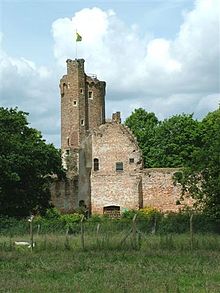Caister Castle
Caister Castle is a 15th century castle and moat in the parish of West Caister , about five miles north of the town of Great Yarmouth in the English county of Norfolk . The castle has a 33 m high keep and was built between 1432 and 1446 for Sir John Fastolf , who (along with Sir John Oldcastle ) inspired William Shakespeare to make Falstaff . Fastolf was one of five noblemen who were founded by King Henry VI. during which 50 years of rule were given permission to fortify their residence. The castle was badly damaged during the siege and capture by the Duke of Norfolk's troops in 1469 . Unlike the keep, the castle fell into ruin after 1600 when a new house was built nearby.
You can climb the keep, which is still undamaged today.
Paston Letters
Sir John Fastolf wanted the castle to be converted into a huge chapel to pray for his soul and that of his loved ones, but after much discussion of his last will, it was instead passed on to the Paston family during most of the Fastolfs Fortune was used to equip Magdalen College in Oxford . Therefore, the castle is mentioned extensively in the Paston Letters , a unique collection of family correspondence written between 1422 and 1509 from the Wars of the Roses , which documents the Paston family's struggle to climb and maintain a position in English society. John Paston was a close confidante and advisor to John Fastolf. Sir John died childless and without a will; the castle was one of many properties on his estate. John Paston claimed the legacy with some justification, which brought him into direct conflict with various powerful people of his time, such as: B. the Duke of Norfolk and Sir William Yelverton . As a result, the castle was besieged in 1469 by the Duke of Norfolk - who claimed it for himself - and defended by John Paston Junior and nearly 30 men. The two-month defense was unsuccessful and resulted in the death of one of Paston's longest and most loyal servants from a crossbow wound and the loss of the castle to the Duke. A few years later the castle was finally returned to the Paston family.
Caister Castle Motor Museum
The Caister Castle Motor Museum houses a private collection of historic sports and touring automobiles and motorcycles. There are also bicycles, wagons, pedal cars, agricultural implements and pieces of transport on display. The exhibitions are located in a specially constructed building.
Entry to the castle also includes the museum, the keep and the property.
Individual references and comments
- ↑ In fact, Henry VI. 23 permits for fortifications, but not one for Caister Castle. Fastolf was one of a group of men who were given permission to fortify Rye House in Hertfordshire . This error comes from the misconception that these fortification permits are an order to build castles. Source: P. Davis: English Licenses to Crenellate 1199–1567 in Castle Studies Group Journal . Issue 20.
- ^ JD Mackenzie: The Castles of England: their story and structure . Macmillan, 1897. p. 348.
swell
- Caister Castle . CastleUK.net
- Caister Castle . ecastles.co.uk
- Site of the Caister Castle Motor Museum
- Caister Castle . Gatehouse Gazetteer.
- Plantagenet Somerset Fry: The David & Charles Book of Castles , David & Charles, 1980. ISBN 0-7153-7976-3
- Stephen Cooper: The Real Falstaff, Sir John Fastolf and the Hundred Years War . Pen & Sword, 2010.
Web links
Coordinates: 52 ° 39 '3.6 " N , 1 ° 42' 4.5" E

